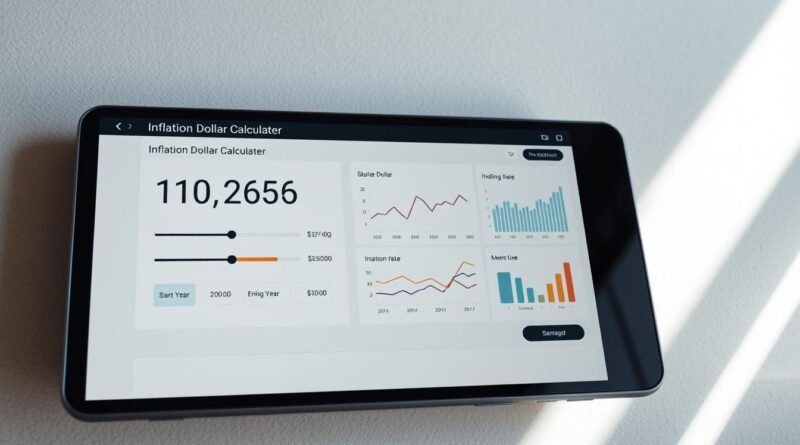Inflation Dollar Calculator: Track Changes in Your Buying Power
Did you know the same item costing $1 in 1913 would now cost over $30? Prices have shifted dramatically over time, and understanding these changes helps you make smarter financial decisions. Our tool uses official U.S. Department of Labor data to measure how your money’s value evolves.
The consumer price index (CPI) shows a staggering 3,773.07% cumulative price increase since 1635. With the current CPI at 321.465, this tool lets you compare purchasing power across any years between 1913 and 2024. Whether planning retirement or negotiating a salary, precise monthly or yearly comparisons give you an edge.
Key Takeaways
- Measure how prices change between any years from 1913 to 2024.
- Uses verified U.S. government data for accurate results.
- Helps with financial planning, like retirement or salary talks.
- Compare monthly or yearly shifts, not just annual averages.
- Includes 2025 CPI projections for forward-looking estimates.
What Is Inflation and How Does It Affect You?

Your money buys less today than it did a decade ago—here’s why. The consumer price index (CPI) tracks how prices for everyday goods and services change over time. It’s the backbone of understanding why your budget feels tighter each year.
Understanding the Consumer Price Index
The CPI measures 200+ subcategories, from groceries to healthcare. Every month, the U.S. Bureau of Labor Statistics collects 80,000 price points from 23,000 businesses. This data paints a clear picture of cost trends.
For example, $100 in 2000 had the same purchasing power as $149.37 in 2020. Here’s how that shift looks across common expenses:
| Item | 2000 Price | 2020 Equivalent |
|---|---|---|
| Movie Ticket | $5.39 | $9.16 |
| Gallon of Milk | $2.78 | $3.32 |
| Median Rent | $602/month | $1,164/month |
Why Prices Erode Your Purchasing Power
Not all costs rise equally. In 2025, core inflation (excluding food/energy) is projected at 2.35%, while headline inflation may hit 4.14%. Housing, for instance, rose 2.80% this year—below its 4.25% historical average since 1967.
This means your dollar stretches thinner for essentials like rent or healthcare. Planning ahead with accurate data helps you stay ahead of these shifts.
How the Inflation Dollar Calculator Works

A 1990s salary feels tiny now, but adjusted for price changes, it tells a different story. Our tool simplifies complex economic data into actionable insights. Here’s how it transforms your numbers across time.
Inputs Needed: Start Year, End Year, and Amount
You only need three details to calculate inflation-adjusted values:
- Start year: When your amount was originally recorded (e.g., 1990).
- End year: The year you want to compare to (e.g., 2025).
- Amount: The dollar figure you’re evaluating (e.g., $50,000 salary).
The formula works behind the scenes: (End CPI ÷ Start CPI) × Original Amount = Adjusted Value. For example, $100 in 2000 equals $149.37 in 2020.
Interpreting Your Results: Adjusted Values Over Time
Monthly CPI data provides sharper accuracy than annual averages. A $50,000 salary in 1990 holds this value today:
| Year | Adjusted Value | Key Change |
|---|---|---|
| 1990 | $50,000 | Base year |
| 2025 | $112,400 | +124.8% |
Negative scenarios occur too. During the 2009 recession, prices dipped 0.34%—rare but impactful. For pre-1913 estimates, economist Robert Sahr’s historical CPI extensions fill the gaps.
Try comparing a $100 grocery bill across decades. You’ll see why planning requires precise data, not guesses.
Key Benefits of Using an Inflation Calculator

The value of money changes over time—here’s how to stay ahead. Tools that adjust for price shifts help you plan with confidence. Whether saving for college or retirement, accurate data beats guesswork.
Planning for Future Expenses
Future costs aren’t fixed. A $35,000 college tuition today could exceed $47,000 by 2035 at a 3% annual rate. Adjusting for these changes ensures your savings keep pace.
Retirement needs similar foresight. A $1 million nest egg today might require $1.34 million in 20 years. Historical averages show why proactive planning matters.
Comparing Historical Prices to Today’s Dollars
See how far your money goes across decades. Median home prices jumped from $23,400 in 1970 to $416,000 today. This table highlights key shifts:
| Item | 1970 Price | 2025 Equivalent |
|---|---|---|
| Median Home | $23,400 | $416,000 |
| New Car | $3,450 | $48,000 |
| Gallon of Gas | $0.36 | $3.50 |
Wages tell another story. A $50,000 salary in 1990 equals $112,400 today. Yet, if pay didn’t match rising costs, purchasing power drops. Tools like this reveal gaps in your financial strategy.
Current Inflation Trends in the United States
Price shifts in 2025 reveal surprising patterns in everyday costs. The June CPI hit 321.465, reflecting an 18 percent surge in energy prices since 2020. For consumers, this means tighter budgets for gas and groceries.
2025 Rate and CPI Data
The core rate (excluding food/energy) sits at 2.35%, below the 4.14% headline figure from 2023. Food costs rose just 2.04% this year—half its historical average of 3.97%.
Energy remains volatile. Gasoline prices swung wildly post-2020 due to supply chain disruptions. Government data suggests this sector drives short-term spikes in the broader economy.
Core vs. Headline Trends
Unlike the 1970s stagflation era, today’s core rate stays near the Fed’s 2% target. Housing and healthcare costs grow steadily, while energy fluctuates.
This split impacts consumers differently. Renters face slower hikes than homeowners, and grocery bills stabilize as fuel costs swing.
Regional Differences in Inflation Rates
Not all areas in the United States experience price change at the same rate. Where you live impacts how far your money goes—whether you’re in New York or St. Louis.
Metro Area Comparisons: New York vs. Los Angeles
New York’s cumulative rise was 99.92% from 1990–2020. That means $100 then equals $199.92 today. In Los Angeles, the same $100 jumps to $221.79—a 121.79% shift.
Why the gap? Coastal cities face steeper housing costs. Midwest areas like St. Louis (2.04% average) benefit from lower demand and manufacturing stability.
Highest and Lowest Inflation Cities (1990–2020)
San Diego led with 3.41% yearly rates, while Houston trailed at 89.62% total change. Energy costs kept Texas cities lower, unlike Boston’s 102.00% climb.
See how your area compares:
- West Coast: Housing drives hikes (e.g., LA +121.79%).
- Midwest: Stable prices (St. Louis +2.04%/year).
- Northeast: Mixed trends (Boston +102.00%).
How Inflation Impacts Specific Goods and Services
Your grocery bill tells a hidden story about shifting costs over time. Some prices spike overnight, while others creep up steadily. Here’s how key categories—from housing to gasoline—affect your budget.
Rising Costs of Housing and Food
Housing costs rose 2.80% in 2025—below the 4.25% historical average. But rents still outpace wages in most cities. A $1,500 apartment today might cost $1,650 in five years.
At the supermarket, eggs cost 38% more than in 2020. Other staples saw sharp hikes:
- Milk: +24% since 2015
- Coffee: +31% over the same period
- Bread: +19%
Energy and Transportation Price Fluctuations
Gasoline hit $3.42/gallon nationally in 2025—down from 2022’s $5 peak. Yet energy remains volatile. Oil market swings directly impact airline tickets and shipping fees.
Compare these trends to steadier services:
| Category | 2025 Increase | Historical Avg. |
|---|---|---|
| Healthcare | 4.93% | 5.10% |
| Education | 3.75% | 4.30% |
“Essential goods like food and fuel react fastest to economic shocks, while services follow slower trends.”
Conclusion: Take Control of Your Financial Future
Your financial power grows when you understand how money changes over time. A $10,000 investment in 2000 would be worth $38,000 today, showing the impact of smart planning.
Start with simple steps. Compare costs across years using reliable resources. Adjust budgets or savings to match rising prices. I Bonds offer protection with a 2.35% variable rate.
One retiree boosted contributions by 15% after seeing adjusted values. This move secured their lifestyle despite shifting costs. Regular updates keep your strategies sharp.
Use tools for regional or sector-specific tracking. Stay ahead by monitoring trends. Your money works harder when you act on data, not guesses.



Pingback: Inflation Data: What You Need to Know